After the visit to the University Library, the group was invited to the Scandinavian Culture Center for a lunch, taken together with other Icelandic guests and many "Western Icelanders". It was a thrill to listen to the 93 years' old Magnús Elíasson, recite to the audience the poem Sandy Bar by Guttormur J. Guttormsson (1878-1966), in perfect Icelandic - Ten long verses from memory!
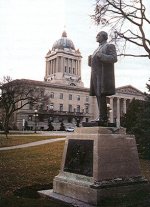 |
The following morning we headed for New Iceland in pure sunshine. A local guide had joined us, Svava Sćmundson. She was just a great guide, knowing everything worth knowing about the area and the people around. She is sister to Elva Simundson, who is well known in the Icelandic communities in Canada and moderator of Icelandic National League of North America Mail list. On their mother's side the sisters descend from Halldór Jónsson and Ingibjörg Jónatansdóttir from the county of Skagafjđrđur, northern Iceland, who emigrated in 1876 and settled on the bank of Icelandic River.
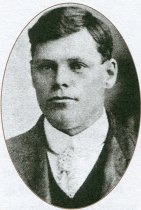 |
By noon we were in historical Gimli. Before that we had of course been out to the even more historical Willow Point where the first Icelandic settlers were forced ashore, October 21, by strong wind, thus prevented to reach Whitemud (Icelandic) River which was their goal (see my Newsletter #13), coming all the way by boat down the Red River from Fisher's Landing, Minnesota. The following day, October 22, 1875, the first Icelander in Western Canada was born, Jón Ólafur Jóhansson, son of Sigríđur Ólafsdóttir and Jóhann Vilhjálmur Jónsson from Eyjafjörđur county in northern Iceland. Read more about the landing at Willow Point here.
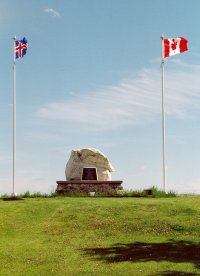 |
Move the mouse over the picture. |
The Gimli town is really a nice place. Everything so clean and tidy. Even the harbour with it's beautiful paintings on the sea wall. We visited the Betel home, got some refreshment at Amma's restaurant and at the H.P.Tergesen & sons' store, I couldn't resist to buy two big and heavy books, "Wagons to Wings" and "Patience, Pride and Progress", books where I find constantly something new and interesting about the settlers and their descendants.
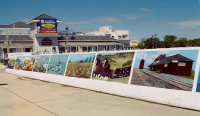 |
 |
The following lines are taken from "The Icelandic People in Manitoba" by W. Kristjanson, Winnipeg 1965: "The Icelandic immigrants in America were from the first concerned about the preservation of their language and nationality. There was common agreement that two things were necessary for the
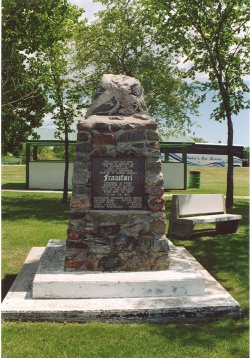 preservation of their precious heritage, a separate colony and a paper in the Icelandic language, published in America. These two projects were so closely linked that it was scarcely to be considered that one could thrive without the other." And further:
"The moving spirit in the enterprise was Sigtryggur Jonasson, who gave generous financial support, and the other chief promoters were Fridjon Fridriksson and Johann Briem, Jonasson's brother-in-law. These three contributed a large share of the capital and formed the board of directors.
preservation of their precious heritage, a separate colony and a paper in the Icelandic language, published in America. These two projects were so closely linked that it was scarcely to be considered that one could thrive without the other." And further:
"The moving spirit in the enterprise was Sigtryggur Jonasson, who gave generous financial support, and the other chief promoters were Fridjon Fridriksson and Johann Briem, Jonasson's brother-in-law. These three contributed a large share of the capital and formed the board of directors.The founding of a paper less than two years after the arrival of the first settlers in the colony,
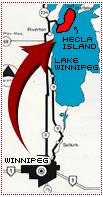 in a community of some fifteen hundred people, the majority of whom were destitute, and in the year of a devastating epidemic, is surely a unique achievement in the history of journalism in America, or anywhere else."
in a community of some fifteen hundred people, the majority of whom were destitute, and in the year of a devastating epidemic, is surely a unique achievement in the history of journalism in America, or anywhere else." Our next goal was Hecla Island, originally called Mikley or Big Island, which together with the nearby Engey - Meadow Island - (now called Goose Island) formed part of the colony of New Iceland which was reserved exclusively by the government of Canada for settlement by Icelanders from 1875 to 1897. The first group of emigrants from Iceland to settle on Mikley came in 1876 - the group commonly known as the large group. They arrived to conditions somewhat better than those who came to New Iceland in 1875 as they found already established settlement of New Iceland.
Religion played an important role in the community. When the Icelanders first arrived the island was served by two ministers who traveled throughout New Iceland and held services in homes until the churches were built. Reverend Páll Ţorláksson and Reverend Jón Bjarnason, disagreed strongly on church doctrine and the potential of the colony. In 1878, convinced that the colony would eventually fail, Reverend Ţorláksson led a large number of settlers to the area around what is now Icelandic State Park near Cavalier, North Dakota. Only eight of the original 26 homesteads on Hecla remained occupied after the exodus, but new arrivals from Iceland took the place of those who had left and the Church became a vital force in helping the community overcome the hardships of pioneer life.
 |
In front of the Hecla Church is a monument with a list of those Icelanders who settled on the island in 1875 in addition the their farms' name. The farms and the farmers are strangely enough numbered from #25 to #49. What about the numbers up to 25? The list is as follows:
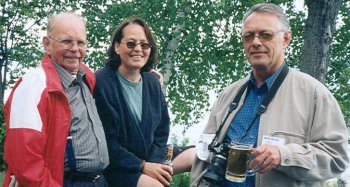 |
From left: Sigurgeir Vilhjálmsson, a native of Hekla Island, son of the settler Vilhjálmur Sigurgeirsson, our guide Svava Sćmundson and yours truly on the veranda of the small restaurant in Gull Harbour, "the quaint little drinking village with a fishing problem". |
Are you related to any of these settlers or do you know any of these names?
Hecla village is really a nice little place, no wonder that many of the houses are now well maintained summer houses. On the tip of the island is the tiny "village" Gull Harbour, - well, hardly a village but a very popular summer resort. The group invaded the first restaurant in sight - are there others? - and until my next Newsletter, I'm gonna sit right down and write myself a - nice postcard :-)
See you!

